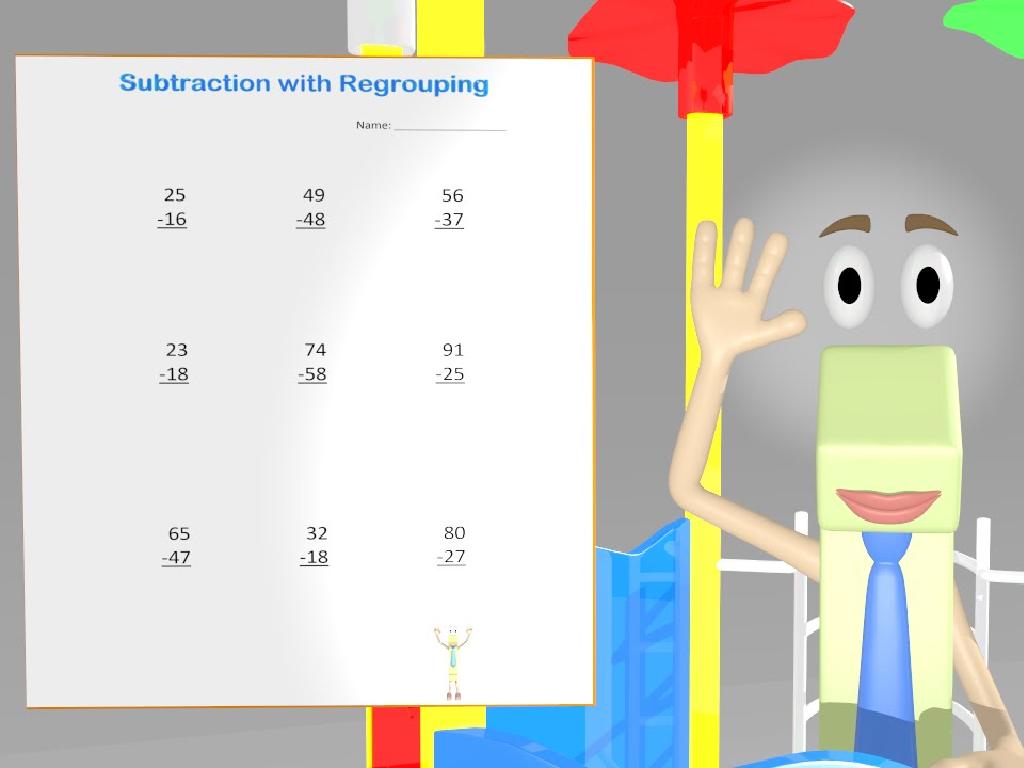Add And Subtract Whole Numbers: Word Problems
Subject: Math
Grade: Fifth grade
Topic: Addition And Subtraction
Please LOG IN to download the presentation. Access is available to registered users only.
View More Content
Introduction to Word Problems
– Understanding word problems
– Word problems describe math in real-life situations.
– Importance of word problems
– They help develop critical thinking and problem-solving skills.
– Today’s goal: Add & Subtract
– We’ll practice adding and subtracting numbers through stories.
– Strategies for solving
– Use clues in the text, identify keywords, and apply math operations.
|
This slide introduces students to the concept of word problems in mathematics, emphasizing their relevance and application to real-world situations. Word problems are a bridge between abstract math and practical use, helping students to develop critical thinking and problem-solving skills. Today’s objective is to focus on addition and subtraction within the context of word problems. Encourage students to look for contextual clues and keywords that indicate which mathematical operations to use. Provide examples and guide them through the process of translating a word problem into a mathematical equation they can solve. This will set the foundation for more complex problem-solving tasks in the future.
Understanding Addition in Word Problems
– Define Addition
– Addition combines two or more numbers into a total.
– Identify Addition Keywords
– Look for words like ‘total’, ‘in all’, ‘together’, ‘combined’.
– Solve an Addition Example
– With 3 apples and 2 more, we add 3 + 2 to find the sum.
|
This slide introduces the concept of addition in the context of word problems. Start by defining addition as the process of finding the total or sum when combining two or more numbers. Highlight key vocabulary that often indicates an addition problem, such as ‘total’, ‘in all’, ‘together’, and ‘combined’. Use the apple example to show a practical application of addition: if a student has 3 apples and gets 2 more, they combine the amounts by adding 3 + 2 to find out they now have 5 apples. Encourage students to visualize the problem with actual objects or drawings to reinforce the concept. The goal is for students to recognize addition scenarios in word problems and to feel confident solving them.
Understanding Subtraction in Word Problems
– Subtraction: Removing numbers
– Clues for subtraction problems
– Words like ‘less’, ‘fewer’, ‘give away’ indicate subtraction
– Example: 5 oranges – 2 oranges
– Start with 5, give away 2, you have 3 oranges left
– Solving subtraction in stories
– Apply subtraction to real-life scenarios for better understanding
|
This slide introduces the concept of subtraction as it appears in word problems, which is a key skill for fifth graders. Subtraction is explained as the process of taking away numbers from a group. The slide highlights keywords that can help students identify subtraction problems in text, such as ‘less’, ‘fewer’, and ‘give away’. An example is provided to illustrate how subtraction works in a practical context, using a relatable scenario of having a certain number of items and then giving some away. The notes should guide the teacher to emphasize the importance of understanding the context of a problem to correctly apply subtraction. Encourage students to think of subtraction as not just taking away, but as finding out how many are left or the difference between amounts. This understanding will be crucial as they tackle more complex word problems.
Mastering Word Problems: Addition & Subtraction
– Understand how to read a word problem
– Learn to identify key information
– Look for numbers, keywords like ‘total’ or ‘difference’, and what the question asks.
– Group activity: Read problems aloud
– Reading aloud can help you catch details you might miss when reading silently.
– Practice with example word problems
– We’ll solve a few problems as a class to apply what we’ve learned.
|
This slide is aimed at helping students develop strategies for tackling word problems in addition and subtraction. Start by explaining how to approach reading a word problem, emphasizing the importance of understanding the problem before trying to solve it. Teach students to identify and underline or highlight important information such as numbers, specific details, and the question being asked. Conduct a group activity where students will read word problems out loud together, which can improve comprehension and ensure they are engaging with the problem. Finally, provide practice with example problems to reinforce these skills. Encourage students to explain their thought process as they identify key information and solve the problems.
Solving Addition Word Problems
– Steps to solve addition problems
– Read carefully, identify numbers, and determine what is being asked.
– Work through an example problem
– Example: If Sam has 15 apples and gets 10 more, how many does he have now?
– Class practice with a new problem
– We’ll solve a problem as a class. Think: What are the key details?
|
This slide is aimed at guiding fifth-grade students through the process of solving addition word problems. Start by explaining the importance of understanding the problem by reading it carefully. Emphasize identifying the numbers involved and the question being asked. Use the example problem to illustrate the process: Sam’s apples provide a concrete scenario for students to visualize. After explaining the example, engage the class with a new problem to solve together. This interactive approach helps students apply the steps they’ve learned. Encourage students to ask questions and discuss their thought process as they work through the problem. The goal is to build their confidence in tackling addition word problems independently.
Solving Subtraction Word Problems
– Steps to solve subtraction problems
– Understand the problem, identify numbers, subtract carefully, and check your work.
– Walkthrough of an example problem
– If Max had 20 apples and gave away 7, how many does he have now? 20 – 7 = 13 apples.
– Class practice with a guided problem
– Solve a new problem as a class, applying the steps we’ve learned.
– Discuss solutions and methods
|
This slide is aimed at guiding students through the process of solving subtraction word problems. Begin by explaining the step-by-step method: understanding what the problem is asking, identifying the numbers involved, performing the subtraction, and then double-checking the work. Use a relatable example problem to illustrate these steps in action. For class practice, present a new problem and solve it together, encouraging students to participate in each step. After solving, discuss different methods that could be used and why the answer makes sense. This interactive approach helps solidify the concept and ensures students are comfortable with subtraction word problems.
Mixed Practice: Addition & Subtraction
– Combine addition & subtraction
– Tips for mixed word problems
– Read carefully, identify keywords, and determine which operations to use
– Pair up for group activity
– Work with a partner to discuss and solve problems
– Solve problems together
– Share solutions and methods with the class
|
This slide introduces students to the concept of mixed practice in word problems, combining both addition and subtraction. Emphasize the importance of reading word problems carefully to identify keywords that signal which mathematical operations to use. During the group activity, students should pair up to solve a set of mixed problems, encouraging collaboration and discussion. Provide guidance on how to approach solving these problems and encourage students to explain their reasoning. As a teacher, circulate the room to assist pairs as needed. Prepare 4-5 different sets of problems so that students can have a variety of examples to work on. After the activity, have pairs share their solutions and discuss any different approaches taken.
Class Activity: Word Problem Scavenger Hunt
– Understand the scavenger hunt rules
– Work in groups to find problems
– Team up and use clues to find hidden word problems around the classroom
– Solve the word problems together
– Use addition and subtraction skills to solve the problems
– Share solutions with the class
– Discuss each group’s findings and methods
|
This activity is designed to make learning interactive and fun. Divide the class into small groups and provide each group with a set of clues to find word problems placed around the classroom. Each problem will require the students to apply their addition and subtraction skills. After finding and solving the problems, groups will reconvene and each will present their solutions and explain the strategies they used. This will not only help students practice their math skills but also encourage teamwork and communication. Possible variations of the activity could include a timed challenge, problems related to real-life scenarios, or incorporating riddles that lead to the next problem.
Wrapping Up: Addition & Subtraction
– Review of key concepts
– Summarize today’s addition and subtraction strategies.
– Practice makes perfect
– Regular practice is crucial for mastering math skills.
– Homework: 10 word problems
– Solve 5 addition and 5 subtraction problems at home.
– Share doubts next class
– Be prepared to discuss any challenges faced.
|
As we conclude today’s lesson on adding and subtracting whole numbers through word problems, it’s important to emphasize the value of practice in mastering these concepts. For homework, students are assigned 5 addition and 5 subtraction word problems to reinforce their understanding. Encourage students to attempt these problems independently, reminding them that making mistakes is a part of the learning process. In the next class, allocate time for students to share their solutions and discuss any difficulties they encountered. This will not only help clarify doubts but also foster a collaborative learning environment.






